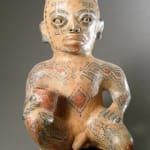Galo Polychrome Kneeling Male Figure, 500 CE - 1000 CE
Terracotta
15.75
PF.3549
Further images
This kneeling male figure comes from the Guanacaste-Nicoya polychrome tradition, the galo polychrome style. Its mirror-bright burnished surfaces are technically unsurpassed by any Pre-Columbian pottery, and yellows, reds, oranges, creams,...
This kneeling male figure comes from the Guanacaste-Nicoya polychrome tradition, the galo polychrome style. Its mirror-bright burnished surfaces are technically unsurpassed by any Pre-Columbian pottery, and yellows, reds, oranges, creams, maroons, and blacks of the polychrome decorations are impressively vivid. Among such sculptures are the full human figures with elaborate representations of tattoos or body paint. Such brilliant polychrome tradition represent an important social dimension; when the northern trade network that brought jade, slate-backed pyrite mirrors, foreign ceramics, and other luxury goods, the Nicoyans responded by producing their own special purpose pottery. Inspired by northern models, it also incorporated local and southern elements, forming a dazzling hybrid style that was traded around Central America and southern Meso-America in the centuries to come. Elaborately decorated with colors and patterns, this sculpted male holding a cup is kneeling in a humble but dignified position. A fine example of galo polychrome figures, he provides a wealth of ethnographic detail because of the realistic style. His flat headdress, facial decoration, and body painting or tattooing are all vividly shown. Elaborate patterns on his chest, arms, and legs accentuate the sculptural beauty, as well as suggesting the ritual function of the figure. Perhaps such distinctive body painting pattern, for example his black ears, fingers and toes, had a specific ritualistic meaning. Holding a small cup, which once possibly contained a powerful potion, this man appears humble and yet strong, like a priest in the midst of a ritual offering.
Literature
V16





